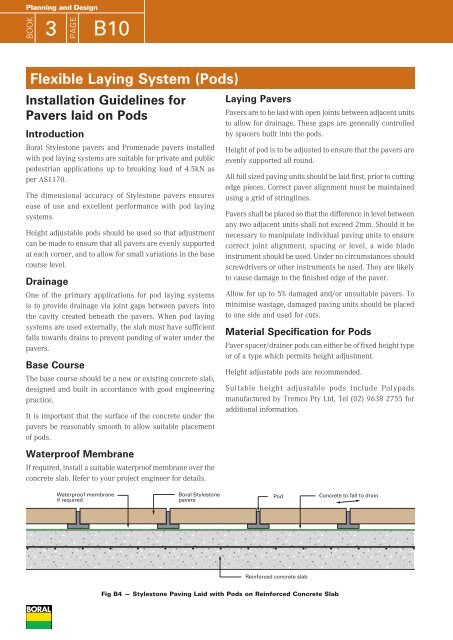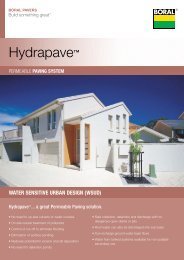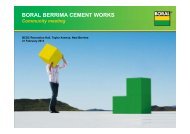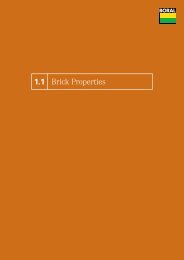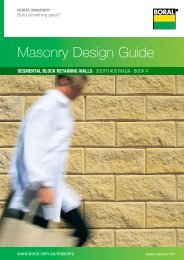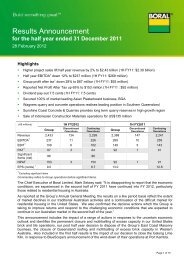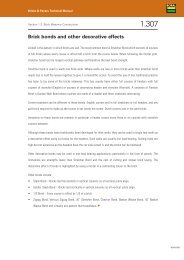Specifications and additional Information - Boral
Specifications and additional Information - Boral
Specifications and additional Information - Boral
Create successful ePaper yourself
Turn your PDF publications into a flip-book with our unique Google optimized e-Paper software.
Planning <strong>and</strong> Design<br />
BOOK<br />
3<br />
PAGE<br />
B10<br />
Flexible Laying System (Pods)<br />
Installation Guidelines for<br />
Pavers laid on Pods<br />
Introduction<br />
<strong>Boral</strong> Stylestone pavers <strong>and</strong> Promenade pavers installed<br />
with pod laying systems are suitable for private <strong>and</strong> public<br />
pedestrian applications up to breaking load of 4.5kN as<br />
per AS1170.<br />
The dimensional accuracy of Stylestone pavers ensures<br />
ease of use <strong>and</strong> excellent performance with pod laying<br />
systems.<br />
Height adjustable pods should be used so that adjustment<br />
can be made to ensure that all pavers are evenly supported<br />
at each corner, <strong>and</strong> to allow for small variations in the base<br />
course level.<br />
Drainage<br />
One of the primary applications for pod laying systems<br />
is to provide drainage via joint gaps between pavers into<br />
the cavity created beneath the pavers. When pod laying<br />
systems are used externally, the slab must have sufficient<br />
falls towards drains to prevent ponding of water under the<br />
pavers.<br />
Base Course<br />
The base course should be a new or existing concrete slab,<br />
designed <strong>and</strong> built in accordance with good engineering<br />
practice.<br />
It is important that the surface of the concrete under the<br />
pavers be reasonably smooth to allow suitable placement<br />
of pods.<br />
Waterproof Membrane<br />
If required, install a suitable waterproof membrane over the<br />
concrete slab. Refer to your project engineer for details.<br />
Waterproof membrane<br />
if required<br />
<strong>Boral</strong> Stylestone<br />
pavers<br />
Laying Pavers<br />
Pavers are to be laid with open joints between adjacent units<br />
to allow for drainage. These gaps are generally controlled<br />
by spacers built into the pods.<br />
Height of pod is to be adjusted to ensure that the pavers are<br />
evenly supported all round.<br />
All full sized paving units should be laid first, prior to cutting<br />
edge pieces. Correct paver alignment must be maintained<br />
using a grid of stringlines.<br />
Pavers shall be placed so that the difference in level between<br />
any two adjacent units shall not exceed 2mm. Should it be<br />
necessary to manipulate individual paving units to ensure<br />
correct joint alignment, spacing or level, a wide blade<br />
instrument should be used. Under no circumstances should<br />
screwdrivers or other instruments be used. They are likely<br />
to cause damage to the finished edge of the paver.<br />
Allow for up to 5% damaged <strong>and</strong>/or unsuitable pavers. To<br />
minimise wastage, damaged paving units should be placed<br />
to one side <strong>and</strong> used for cuts.<br />
Material Specification for Pods<br />
Paver spacer/drainer pods can either be of fixed height type<br />
or of a type which permits height adjustment.<br />
Height adjustable pods are recommended.<br />
Suitable height adjustable pods include Polypads<br />
manufactured by Tremco Pty Ltd, Tel (02) 9638 2755 for<br />
<strong>additional</strong> information.<br />
Pod<br />
Reinforced concrete slab<br />
Fig B4 — Stylestone Paving Laid with Pods on Reinforced Concrete Slab<br />
Concrete to fall to drain


